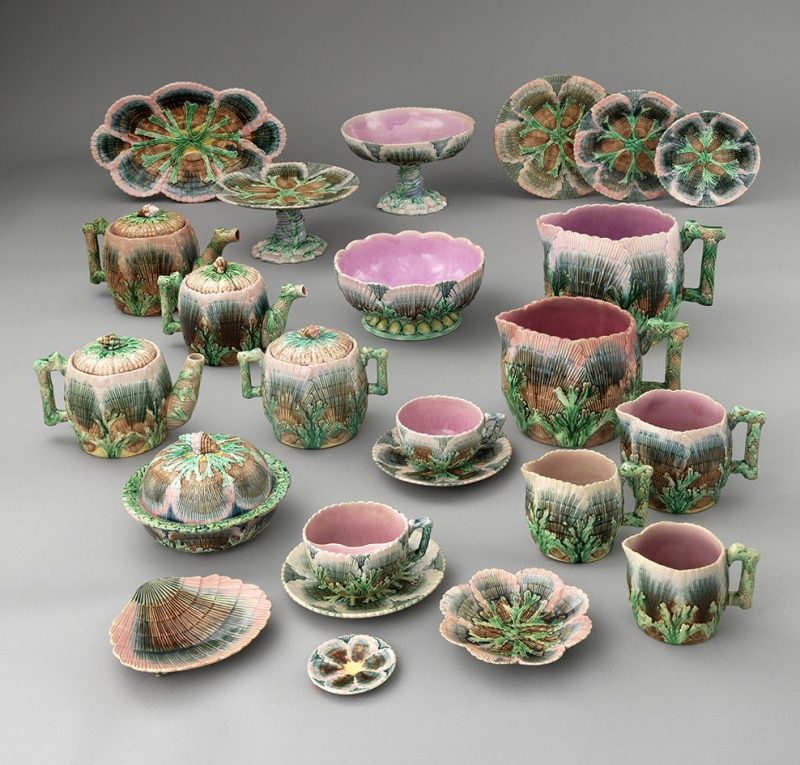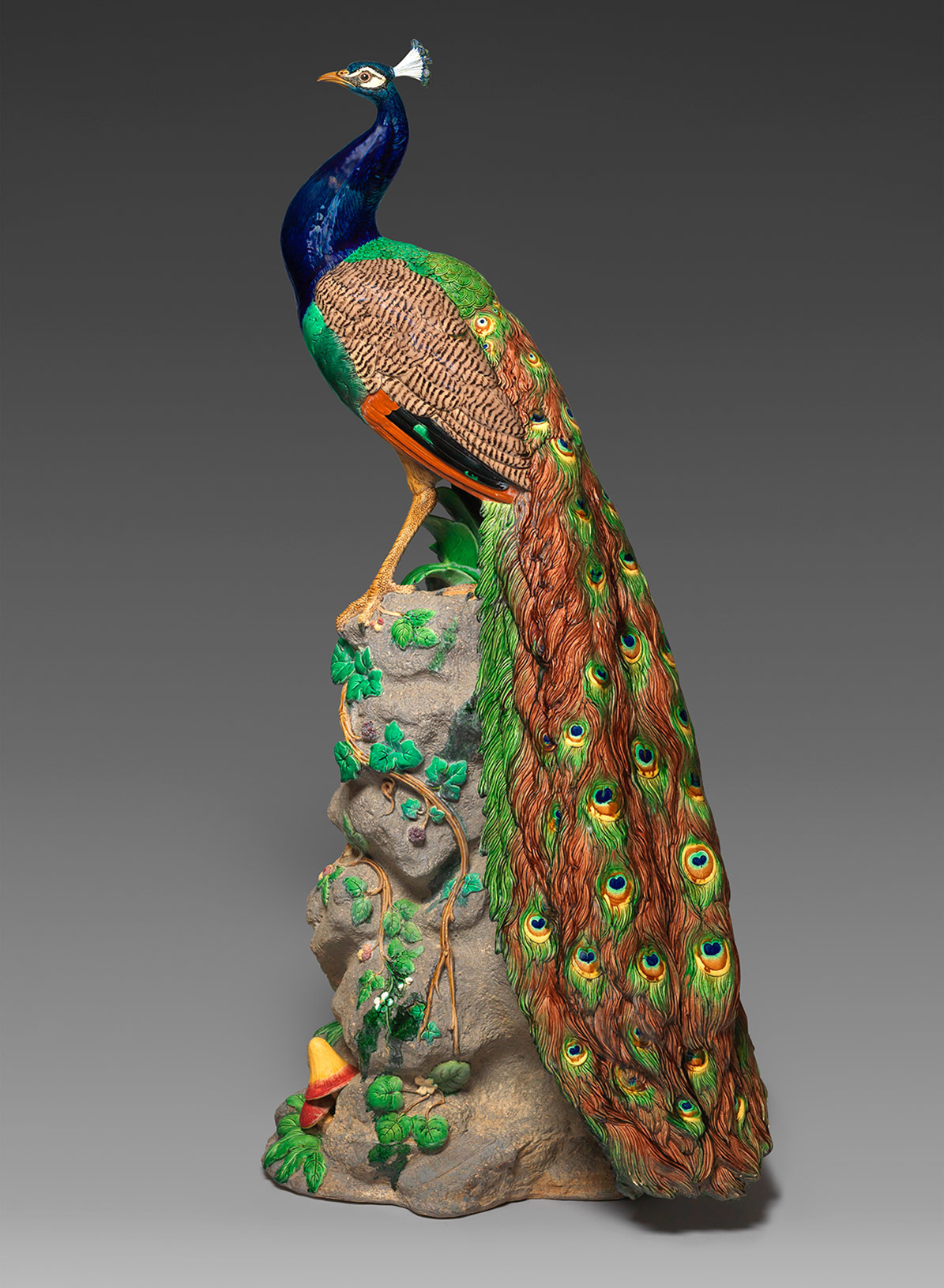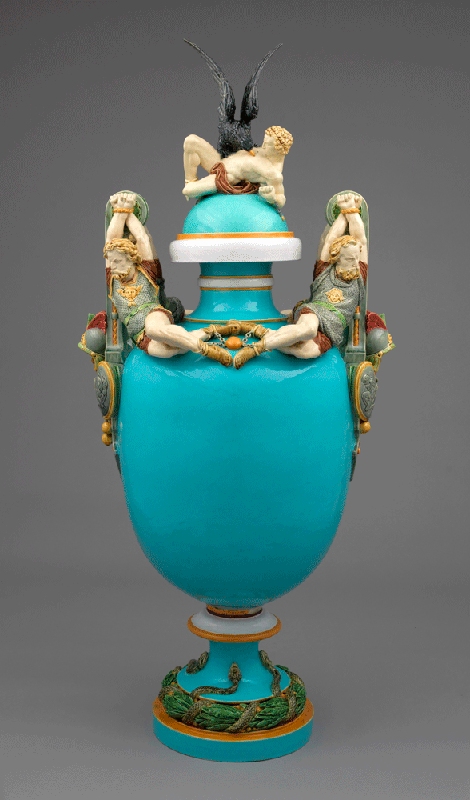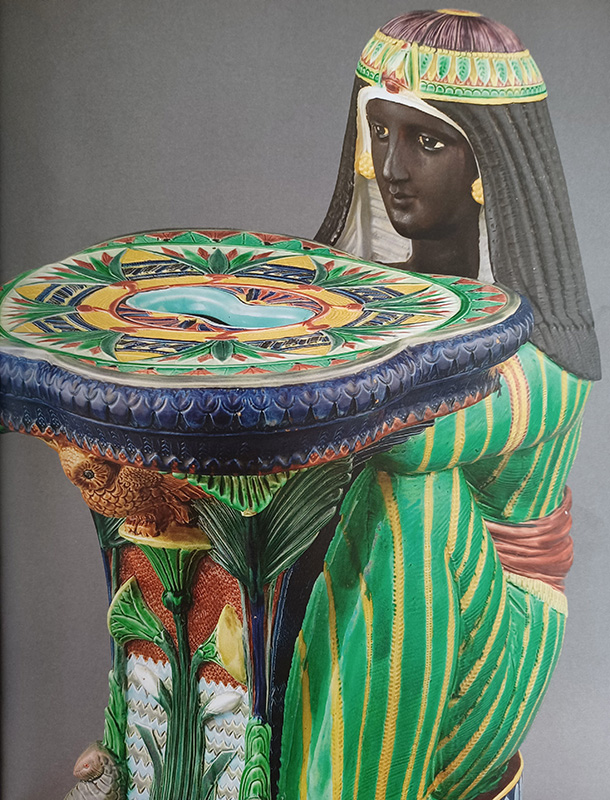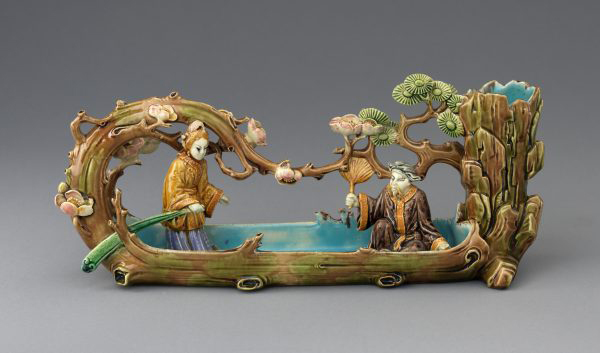A Fantastical World of Toxic Beauty: Majolica Mania at the Bard Graduate Center Gallery
by Juliana Fagua Arias
Walking into Majolica Mania: Transatlantic Pottery in England and the United States, 1850-1915 is like falling into the whimsical Victorian universe of Alice in Wonderland. Colorful creatures welcome the visitor to a world of capricious fantasy, indulgence, and decadence, but also profound creativity and imagination. Majolica is a type of earthenware developed in 19th-century England, produced later in the United States, characterized by saturated glazes and intricate decoration of realistically rendered characters. Majolica designers gathered inspiration from botany and zoology, as well as from historical precedents such as Italian Maiolica1 and neo-gothic and Greco-Roman forms. This type of ceramic ranges from domestic objects—such as teapots, dining services, and garden seats—to monumental pieces displayed at World’s Fairs and architectural decorations. The largest exhibition of majolica ever mounted, Majolica Mania both saturates the visitor’s senses and stimulates their intellectual curiosity by addressing the complicated histories of gender, class, and race inequalities that lie beneath the glossy surface.
Throughout four floors and eight galleries, curators Dr. Susan Weber and Dr. Jo Briggs examine majolica from a variety of perspectives, considering its artistic, historical, social, cultural, and economic origins and impact. The first-floor gallery is dedicated to majolica’s introduction and varied design sources. The second-floor galleries address majolica’s use for the display of houseplants and bringing nature indoors, the process of making majolica, Minton as Britain’s premier manufacturer of majolica, and the expansion of British majolica manufacture, in which firms like Josiah Wedgwood & Sons played a key role. The third-floor galleries examine the introduction of majolica to the United States, the British pottery industry and the working conditions in the potteries, and the use of majolica in the Victorian dining room, where colorful wares made up the ideal table setting. The fourth-floor galleries are dedicated to majolica in the United States and the American pottery manufacturing centers, namely East Liverpool, OH, and Trenton, NJ.
Paul Comoléra, designer, Minton & Co., manufacturer, Peacock, shape no. 2045, designed c. 1875, this example 1876. Earthenware with majolica glazes. The English Collection. Photograph: Bruce White.
Throughout the exhibition, the visitor is constantly straddling between majolica itself—the techniques, aesthetic influences, and materials that make up these jewel-like pieces—and the larger social and commercial contexts that surrounded its production, marketing, and distribution. This change of pace allows for moments of reflection and contemplation as well as moments of pure delight and admiration for the medium.
Most interestingly, Majolica Mania does not shy away from the underlying tensions of the production of majolica; its toxic beauty, so to speak. The first two objects that the visitor encounters are the famed Peacock designed by Paul Comoléra (1818-1897) for Minton & Co., and the contemporary sculpture A Requiem in White by Walter McConnell, commissioned for this exhibition. The former epitomizes the technical and aesthetic achievements of majolica, and the latter commemorates the workers in majolica potteries, mostly women and children, who lost their lives due to the high levels of toxic lead in the distinctive saturated glazes.
These uncomfortable but intriguing tensions pop up throughout the exhibition. The encyclopedic categorization of majolica manufacturers and the identification of male designers by name stands in contrast with the anonymity of the thousands of female paintresses who worked at the factories in precarious health conditions. On the other hand, the abundance of quirky motifs and characters rendered in majolica—a pair of Japanese boatmen here, a female Egyptian figure there—hide an oppressive story of colonialism and systematic racism that encouraged designers to extract motifs devoid of context or render black figures in subservient positions. The Blackamoor motif, of which the garden seat is a subdued example, was employed in the production of Majolica, and depicted a black person dripping in jewelry but often carrying or offering something (candles, a tray, a seat etc.). These romanticized depictions obscured the cruel reality of European colonies (Egypt was occupied by the British from 1882 until 1956) and created a palatable image for the white, high classes back in the metropolis. The fact that the designers of this garden seat paid no attention to facial features, painting in black a rather Caucasian face, demonstrates that they had no close contact with the Egyptian culture beyond profiting from an exoticized imagery.
The notion of class was also key in majolica production, as pottery workers, which included children as young as eight years old, toiled between 12 and 14 hours a day in harmful conditions to satisfy the artistic cravings of wealthy patrons, including Queen Victoria and Prince Albert.
Outside of the exhibition itself, the Bard Graduate Center has created various venues to further explore the world of majolica. An online exhibition is available and equipped with multiple interactive media, including 3D models of some of the exhibition’s most beautiful objects. Selected essays extracted from the three-volume catalogue are also available in the online exhibition. Furthermore, public programming scheduled for the fall will dig deeper into controversial yet fascinating subjects such as Black and Asian figures in majolica imagery and the toxic side of some of the world’s most vibrant pigments. It will also bridge the world of majolica in Victorian England to contemporary issues and makers, including a conversation about lead activism in the United States, and a reading by acclaimed poets Wayne Koestenbaum, Sally Wen Mao, S*an D. Henry Smith, and Stacy Szymaszek, of poems commissioned specially for the exhibition.
Majolica Mania will satisfy the visitor’s aesthetic and intellectual curiosities, opening up a fantastical world of lively creatures, dark humor, and brilliant glazes. Yet, it also uncovers the downsides of its production, the social inequalities that sustained it, its colonial undertones, and its toxic beauty.
Majolica Mania conveniently coincides with an exhibition happening right across Central Park, Gifts from the Fire: American Ceramics from the Collection of Martin Eidelberg, which opened on October 21 at The Metropolitan Museum of Art. Focusing on the United States art pottery movement of the late 19th and early 20th centuries, Gifts from the Fire illuminates the accomplishments of art potters from across the United States and highlights their connections with European potters and artistic movements. Commercial and marketing venues such as World’s Fairs and printed media, besides the migration of potters itself, bridged both sides of the Atlantic, and the creative outcome of these networks can be enjoyed by ceramic enthusiasts in both Majolica Mania and Gifts from the Fire.
Juliana Fagua Arias is a contributing writer for The Decorative Arts Trust Bulletin.
1 Although usually confused for each other, Italian Maiolica refers to the tin-glazed earthenware produced in Italy in the early fifteenth century, while English Majolica refers to the particular type of earthenware manufactured in Britain in the middle of the nineteenth century. Both are achieved by the addition of tin oxide to a lead glaze, producing a white, opaque, smooth surface. However, Italian Maiolica was mostly used to represent mythological or religious subjects in varied but subdued colors, whereas English Majolica usually depicted whimsical subjects in saturated and bright colors.
About The Decorative Arts Trust Bulletin
Formerly known as the "blog,” the Bulletin features new research and scholarship, travelogues, book reviews, and museum and gallery exhibitions. The Bulletin complements The Magazine of the Decorative Arts Trust, our biannual members publication.








